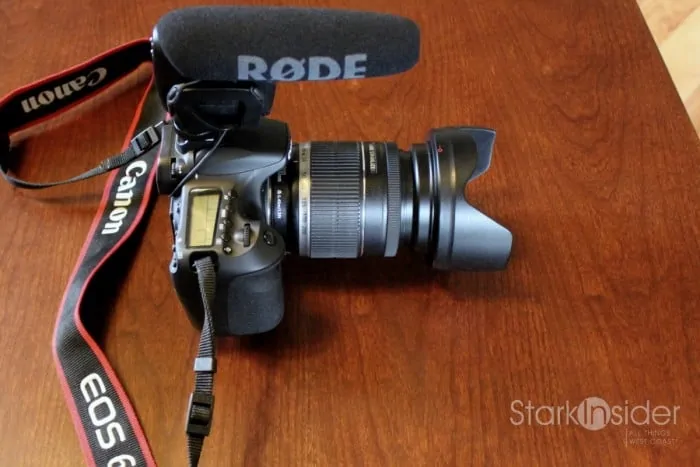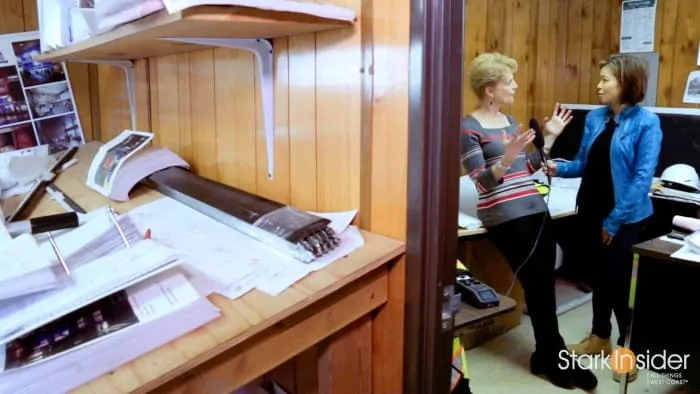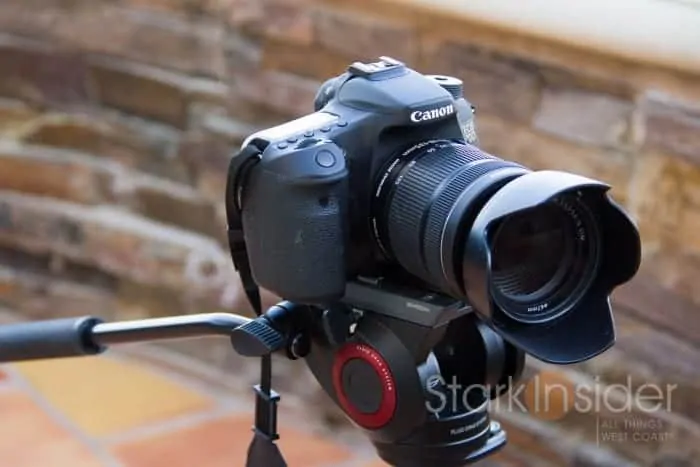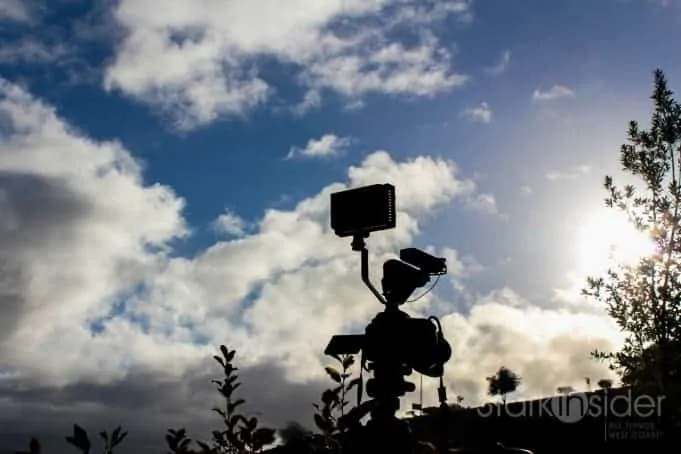Buying a DSLR (or mirrorless) camera is just the first step in your video journey. Part of the fun is kitting out, gradually adding an accessory here and there over the years, and learning the ins and outs of video production along the way. Baby steps, as they say.
Whether you’re just venturing into the world of DSLR video for the first time, or already have a few years under your belt and are ready to take it to the next level, here are 5 accessories that can help you improve the quality of your videos. (If you are still researching what camera to buy, check out my Top 5 DSLR and mirrorless camera picks, you’re in for a treat as today there’s an incredible array of low-cost, amazing cameras)
I’ve been shooting video for Stark Insider professionally since 2009 (you can see our work on the SI YouTube channel) — when we first shot a segment with the cast of the Kite Runner. My first camera was a good old Canon Vixia camcorder. Next, I joined the DSLR revolution and bought a superb (and now considered a modern classic) EOS Rebel T2i. And the upgrades followed, next to the EOS 60D, and, finally to the 70D, my daily DSLR of choice since its release in 2013. Each of these accessories has been in my rig and used on a regular basis, all have acquitted themselves with high quality results and impressive durability.
Quick tip:
Don’t be that dude at the gym with all the brand spanking new gear. You know: new shorts, cool Under Armour shirt, and $300 tricked our Jordans. In another words, don’t buy all new stuff all at once. In my experience at least that’s a recipe for overload. Instead buy something new, test it, work with it, learn it, and integrate it carefully into your workflow. Then, once your comfortable with, say, how to operate your new light panel, move onto something else, maybe audio. You may surprise yourself how effective you can become.
So with that, here are 5 DSLR accessories (that won’t break the bank!) for shooting video worthy of your consideration.
1. Rode Videomic Pro Shotgun Microphone

Quality audio is essential for quality video. We will tolerate shaky or less than the sharpest image at times (documentaries are good examples), but most audiences will quickly shut-off something with poor audio. And when it comes to low-cost professional audio for DSLRs and mirrorless cameras, Rode is the gold standard. What I like about the Videomic Pro: it’s compact, runs forever on a battery (9V) and uses a standard 3.5mm jack. There’s a reason why amateurs and pros alike recommend this mic.
Rode Videomic Pro – superb mic will up-level your video audio quality in a big way.
Step-up:
Sennheiser MKE 600 Shotgun Mic – a bit more expensive, and less convenient as it requires an XLR-3.5mm adapter and is larger than the Rode, but I find provides more bass, and reduced hiss.
2. Neewer 160 LED Dimmable Light Panel

Light your subject. Simple enough! Here’s an easy way. Just pop this $29 LED panel onto the hot shoe on your DSLR and you’ll have a high power, dimmable way to light your scenes. I don’t always recommend lighting. Sometimes shooting in natural light is preferable, possibly even more dramatic. When I’m backstage at dark theaters shooting segments for Stark Insider, like I did recently for Addams Family, a light is often mandatory. This is a great panel for shooting weddings, birthday parties, or, even professional on the red carpet or wherever your video travels take you.
Neewer 160 LED Dimmable Light Panel – light your subject, runs almost 2 hours on battery, comes with diffuser to soften and evenly distribute light (I leave it on all the time)
PS- the Neewer is a dirt cheap panel, with basic plastic construction, but it works. If you’re getting really serious and understand terms like “color correction and grading,” consider a panel from Genaray.
3. Zoom H6 Portable Field Recorder

I love, love this recorder. I used it recently to shoot a short feature about the new Strand theater in San Francisco. The voiceover (see embed below) was captured on the Zoom H6. Using professional XLR jacks make a huge difference, as do the pre-amps which are leagues better than most DSLR and mirrorless cameras. You will need to sync the audio in post production, so extra work is required. But this recorder should help you take your videos to the next level. Hint: also superb for live concerts!
Example of voiceover captured with Zoom H6: The Strand
Zoom H6 Portable Recorder – absolutely spectacular performance. Use it for weddings, live music concerts, voiceovers, and more. Versatile.
4. Manfrotto Carbon Fiber Tripod

I bit the bullet. Finally, last year, and dolled out some cash for a better tripod. Yes, you can make do with a cheap one from Costco. I did for years. At some point though you’ll want something lighter, and also something that has robust connectors and the ability to accommodate a smooth, fluid head.
Manfrotto 190CXPRO Carbon Fiber Tripod
The head I use is this one:
Manfrotto MVH500AH Flat Base Pro Fluid Head
All in that’s almost $600 with taxes for just a tripod. If you’re just starting out this one might be at the bottom of your list (think audio, lighting first). If you’ve already been shooting for several years and have always neglected to upgrade your tripod along with your other gear (like me), it could be time to also bite the bullet – your back will thank you, so will your beautiful, cinematic pans.
5. Rokinon Cinema Lenses

Bokeh time! Chances are, you bought your camera with a kit lens. My current favorite and recommendation is the Canon EOS 70D (with its amazing continuous dual-pixel auto-focus) paired with the equally killer 18-135mm STM lens. You can find that 70D kit on Amazon, but you should also check your local Costco for a deal. Cinema lenses, though, are made specifically for shooting video. They typically have clickless aperture rings and manual focus – meaning they require more skill, and effort to use. If you have the inclination and patience, the results can approach indie film. Gorgeous bokeh, Stunning color reproduction. My favorites are made by Rokinon. By cine standards they are really affordable. And if you scour filmmaker forums you’ll find pros use them all the time on serious cameras, like ones made by RED, Blackmagic and Sony. Keep in mind, these aren’t the best for run-and-gun… you’ll need time to focus, compose your shots, and because these Rokinons don’t have image stabilization you may want to use a tripod or gimbal of some kind to steady the shots.
Also: these Rokinons are fast (f 1.4) and are well suited for low light shoots.
I’d start with the Rokinon 85mm or Rokinon 50mm. Keep in mind with an APS-C crop sensor (typical on Canon DSLRs) you need to mulitply by 1.6 to get the 35mm equivalent of the focal ranges.
Also consider: the new Canon 50mm f1.8 50mm. While not a true cinema lens (there’s no manual aperture control for instance) you’ll still get luscious bokeh, and a gorgeous image for a ridiculously low price. There’s a reason why people refer to these Canon classics as the “nifty fifty.”
Note: the above recommended lenses use the Canon EF mount, which is a popular mount for indie filmmakers and professionals, and amateurs alike. The Rokinons are also available with a Nikon mount.
Clint’s Top 5 Accessories for shooting video with DSLR and mirrorless cameras

There you have it. My top picks for best DSLR accessories — ones that I’ve been using happily over the years.
For those that just jump to the bottom of the post as I do from time to time, a quick summary:
1. Rode Videomic Pro Shotgun Microphone
2. Neewer 160 LED Dimmable Light Panel
3. Zoom H6 Portable Field Recorder
4. Manfrotto Carbon Fiber Tripod
5. Rokinon Cinema Lenses
One final note. If you start popping on lights, mics, monitors, and other accessories, you’ll need something like this mount bracket. It slots into your hotshoe, and in this example from ePhoto, give you three mount points (cold shoes with no power) for inserting your accessories.
ALSO SEE: Top 5: Best DSLR Cameras for Shooting Video
Thanks for dropping by Stark Insider.
Have fun out there shooting video!


